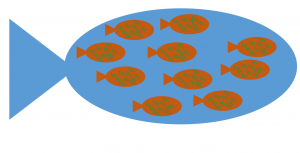Bioaccumulation – explained in a nutshell
Bioaccumulation is the accumulation of certain substances in an organism via food or the surrounding medium.
The conversion of energy from food into biomass is incredibly inefficient. On average only 1/10 of what is consumed is transformed into biomass, the rest is lost in maintenance. This also means that an animal needs to consume 10 times its body mass in order to maintain itself. While from this large amount that is consumed, only 1/10 is kept in biomass, the toxins, like for example mercury, pesticides or microplastic, are kept from all 10/10.
 As a consequence, these toxins tend to accumulate in larger and larger amount as we move up the food chain. Each food chain level having 10 times the amount of toxins, if its prey had carried the toxin. This bioaccumulation is a good argument for eating species comparatively low on the food chains, with plants, as primary producers not having accumulated as much toxin as a carnivorous fish like tuna would have.
As a consequence, these toxins tend to accumulate in larger and larger amount as we move up the food chain. Each food chain level having 10 times the amount of toxins, if its prey had carried the toxin. This bioaccumulation is a good argument for eating species comparatively low on the food chains, with plants, as primary producers not having accumulated as much toxin as a carnivorous fish like tuna would have.
This short video explains bioaccumualtion on the example of pesticides:
Check out our cheat sheet for more short explanations connected to environment and climate.
photo: pixabay

